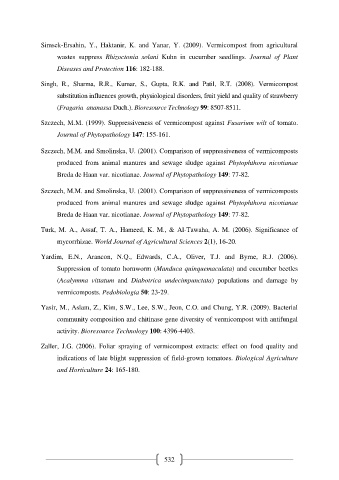Page 542 - e-Book
P. 542
Simsek-Ersahin, Y., Haktanir, K. and Yanar, Y. (2009). Vermicompost from agricultural
wastes suppress Rhizoctonia solani Kuhn in cucumber seedlings. Journal of Plant
Diseases and Protection 116: 182-188.
Singh, R., Sharma, R.R., Kumar, S., Gupta, R.K. and Patil, R.T. (2008). Vermicompost
substitution influences growth, physiological disorders, fruit yield and quality of strawberry
(Fragaria ananassa Duch.). Bioresource Technology 99: 8507-8511.
Szczech, M.M. (1999). Suppressiveness of vermicompost against Fusarium wilt of tomato.
Journal of Phytopathology 147: 155-161.
Szczech, M.M. and Smolinska, U. (2001). Comparison of suppressiveness of vermicomposts
produced from animal manures and sewage sludge against Phytophthora nicotianae
Breda de Haan var. nicotianae. Journal of Phytopathology 149: 77-82.
Szczech, M.M. and Smolinska, U. (2001). Comparison of suppressiveness of vermicomposts
produced from animal manures and sewage sludge against Phytophthora nicotianae
Breda de Haan var. nicotianae. Journal of Phytopathology 149: 77-82.
Turk, M. A., Assaf, T. A., Hameed, K. M., & Al-Tawaha, A. M. (2006). Significance of
mycorrhizae. World Journal of Agricultural Sciences 2(1), 16-20.
Yardim, E.N., Arancon, N.Q., Edwards, C.A., Oliver, T.J. and Byrne, R.J. (2006).
Suppression of tomato hornworm (Manduca quinquemaculata) and cucumber beetles
(Acalymma vittatum and Diabotrica undecimpunctata) populations and damage by
vermicomposts. Pedobiologia 50: 23-29.
Yasir, M., Aslam, Z., Kim, S.W., Lee, S.W., Jeon, C.O. and Chung, Y.R. (2009). Bacterial
community composition and chitinase gene diversity of vermicompost with antifungal
activity. Bioresource Technology 100: 4396-4403.
Zaller, J.G. (2006). Foliar spraying of vermicompost extracts: effect on food quality and
indications of late blight suppression of field-grown tomatoes. Biological Agriculture
and Horticulture 24: 165-180.
532

